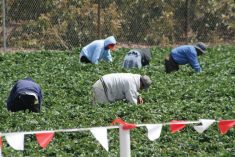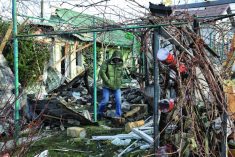[UPDATED: April 20, 2021] The threat of open-pit mining in the Eastern Slopes has Laura Laing spending hours every day researching everything from coal exploration techniques to selenium contamination.
It has Callum Sears frustrated and angry.
And they are just two of a host of ranchers and landowners in the southern foothills — and beyond — who are alarmed by the prospect of coal development they all assumed could never happen.
Read Also

Farming Smarter receives financial boost from Alberta government for potato research
Farming Smarter near Lethbridge got a boost to its research equipment, thanks to the Alberta government’s increase in funding for research associations.
“On this issue in particular, the government sure seemed to galvanize everybody against them,” said Sears, who ranches near Stavely and is president of the Western Stock Growers’ Association.
“It’s just foolish. I don’t care what you think about coal mining. The way they went about this, it’s just wrong.”
Last May — on a Friday afternoon just before the long weekend — the UCP government quietly issued a notice it was cancelling a 1976 policy that had put wide swaths of the foothills and Rocky Mountains off limits for coal exploration and development.
Despite the low-key announcement and the pandemic, word soon spread and opposition mounted. Public pressure from ranchers, Indigenous groups, landowners, environmentalists and even celebrity musicians such as Paul Brandt and Corb Lund forced the government to reinstate the coal policy in February.

“What we’re doing today — keeping the 1976 coal policy in place and committing to consult on a modernized policy — is what we should have done in the beginning,” Energy Minister Sonya Savage said at the time.
But despite that pledge, there is widespread concern that the UCP government, anxious to revive the battered Alberta economy, wants to encourage new metallurgical coal developments. (Unlike thermal coal burned for power generation, metallurgical coal is used in steel making, and will be sold overseas to countries such as China.)
“To date, nearly all of the government consultation we have been exposed to and partaken in has been engineered and manipulated to yield the government’s preferred conclusions,” the Western Stock Growers’ Association said in an update to its members after the February about-turn.
*The reinstatement of the 1976 coal policy pauses the issuing of any new coal mining leases. But for leases issued prior to the reinstatement, exploration work can continue, which includes activities such as test drilling and building of access roads. But like the stock growers, Laing and husband John Smith, who own Plateau Cattle Company near Nanton, also aren’t pinning their hopes on the government’s new-found interest in consulting the public.
Although the president of one group of area residents, the Livingstone Landowners Group, is on a five-person panel appointed by Savage to review the coal policy (which the government describes as outdated), there are no producers on it, Laing noted.
“There’s no one representing ranchers or agriculture, period, and that concerns us,” she said, adding she is very worried about the effects of coal development on the land, the water, and the air.
“We have a lot of concerns for our livestock, as well as for ourselves as Albertans. We’re probably looking at the biggest coal development in North America out our back door — 1.5 million hectares.
A host of issues
Smith and Laing’s grazing allotment is about 40 kilometres from their ranch, up in the Cabin ridge area of the Mount Livingstone Range.
The area is considered Category 2, a protected land that prevented development under the 1976 coal policy enacted by then premier Peter Loughheed. Much of the proposed exploration and development of mines is taking place in some historic grazing areas.
“Category 2 land is incredibly sensitive,” said Laing.
The couple is party to a legal request asking for a judicial review of the government’s attempt to rescind the coal policy and also part of the Pekisko Group. The latter, a longtime association of ranchers and families from the Pekisko rangeland area, is funding a study into how open-pit coal mining could affect air quality.

The Livingstone Landowners Group has also hired experts to assess the potential impact of the proposed Grassy Mountain Coal Project on water quality and quantity in the Oldman River system.
“If you were to overlay a map of the headwaters on the proposed area, they’re right in the middle of it,” said Bobbi Lambright, a landowner who lives west of Highway 22 and is the secretary of the Livingstone Landowners Group.
“The No. 1 issue for us is the fact that the open-pit mountaintop removal coal mining is proposed right in the headwaters.
“This is a fairly semi-arid climate at the best of times. The headwaters are critical to support the communities, to support farming and ranching communities, and to support most of the existing water use through most of Alberta and into Saskatchewan and Manitoba.”
Like Laing, members of the group are looking at a wide range of issues — from the 1976 coal policy to how selenium is released by coal mining and seeps into waterways.
“You start following the thread and the thread starts to take you down a path that starts to terrify you,” said Lambright.
For many, the threat of selenium contamination is particularly scary.

Although naturally occurring and harmless in small quantities, selenium becomes toxic when concentrations get too high. The inorganic version of the mineral is water soluble and can be taken up by plants and converted to organic forms, which can then build up in the food chain. This is raising concerns that selenium pollution could have a major impact on the irrigation and feedlot sectors as they draw water from the Oldman watershed.
Laing said she has talked to people in B.C.’s Elk Valley, home to four metallurgical coal mines, who have had their wells contaminated by selenium and must now use bottled water.
“What we know today is that no one has proven that selenium will not leach out or contaminate, and that concerns us a lot,” said Laing.
Mines in the Elk Valley have had a real struggle trying to deal with selenium contamination, said Shannon Frank, executive director of the Oldman Watershed Council.
“There’s been a real selenium buildup over time,” she said. “They’ve invested hundreds of millions of dollars in water treatment, but over time, some things have worked and some things haven’t.”
Fish exposed to selenium at parts higher than two micrograms per litre can be deformed or have reproductive failures, she said.
“If you got beyond that, you would start to see health impacts on the livestock,” said Frank. “Selenium can cause illness for humans, and make your hair fall out and make you have digestive problems.”
An uncertain future
The issue of drawing water for coal mines is in itself controversial.

“Since the coal mines have been lobbying to develop the Eastern Slopes, the provincial government has expressed a willingness to revisit the water allocation structure and to make more of the water available to the coal mines,” said Lambright.
That should be a non-starter, too, said Sears.
“Agricultural producers have been wanting more access to water for decades and we’ve been told for decades that the Oldman watershed is fully allocated. If you want more water rights, you have to buy them off someone not using them,” he said.
“And then to have the coal companies just show up and get water rights — that’s bizarre that, that would happen.
“We’re not anti-coal, we’re not anti-industry, but we’re anti-stupidity.”
That view is echoed by Laing.
“Coal mining is extremely water intensive,” she said. “Where are we going to get this water? We’re in some of the driest parts in Canada. It’s very arid and dry, and we’ve heard they’re going to go after the Oldman to support coal development. That’s a huge concern.”
Laing said she has been in this fight for over a year, and spends five to seven hours a day researching issues and collaborating with other concerned landowners, even though she has a full-time job in addition to ranching.
“We’re not in this fight by choice. It is time consuming from a mental and emotional perspective. It’s a long, hard road,” she said.
Lambright is worried about the present impacts, even from exploration, which has increased in the region.
“It opens that up, not just for the coal company, but for access to other users,” she said. “It’s destructive of the grasslands, it takes down trees and it impacts water flow. It’s significant for people who have relied on the historic ranchland.
“We’re going to see a lot of rough fescue and native grassland disturbed. It’s a very unique area and it’s quite devastating to think of these mines going in there and tearing out the grasslands and the different pines, and disrupting so many operations.”
Sears is planning to discuss the new review panel at an upcoming Western Stock Growers’ Association meeting. Although he is taking a “wait-and-see” approach, he is also concerned the government has already determined “the outcomes they want.”
“I’m not overly optimistic,” said Sears. “The ball is in the government’s court right now, as it looks like to me. We’ve got to see what the panel says, but we know how these panels go.”
*Update: Context regarding coal leases was added.
















